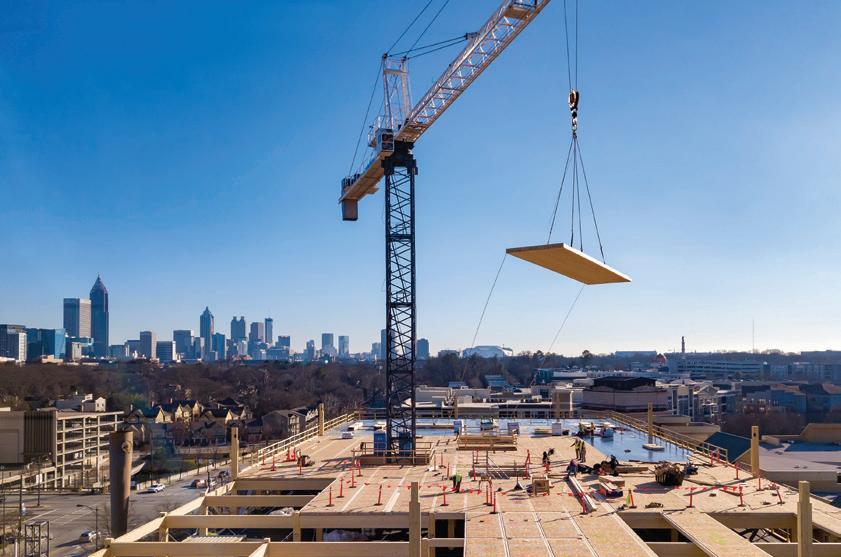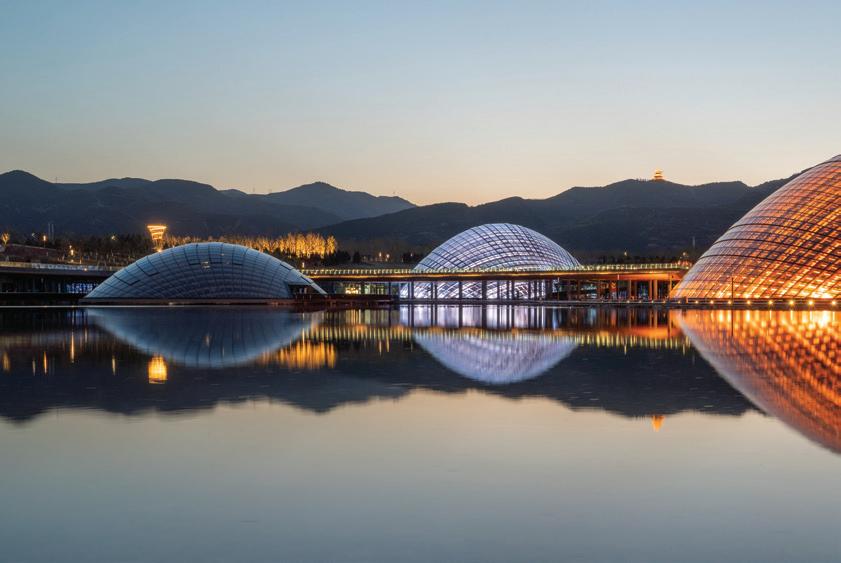
5 minute read
PARAMETRIC DESIGN Wood for Thought: Is Parametric Design the Answer?
Is Parametric Design the Answer?
It depends on the question
Advertisement
Lucas Epp, P.E., P.Eng.
Three dramatic timber gridshells with clear spans up to 300 ft. at the recently opened Taiyuan Botanical Garden in Taiyuan, China.
A new era of timber architecture has arrived. From taller wood buildings to customized freeforms, use of timber as a construction material is driving change in the way we design, manufacture and construct buildings. Across all building types, mass timber is proving to be a viable new material. Mass timber production lines enable efficient “Batch Size One” manufacturing, allowing for mass customization perhaps more readily than other materials. Each glulam or CLT piece can be unique without adding complexity or significant extra cost to the manufacturing process. This CNC manufacturing process also creates an inbuilt instruction set for assembly, reducing time and required skill on construction sites, and
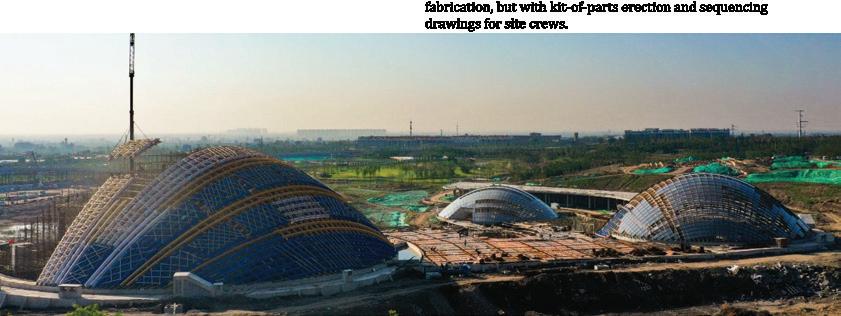
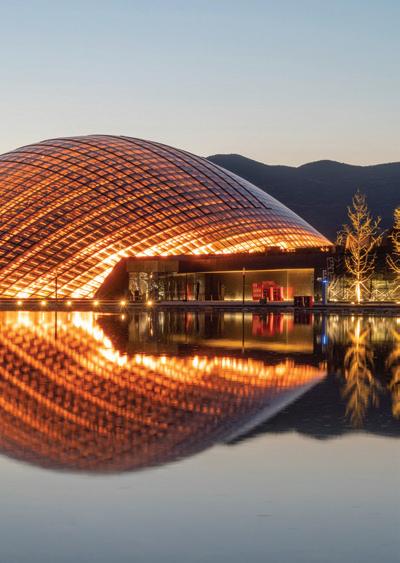

moving more construction to an indoor, robot-controlled environment.
But what is next for mass timber? The mass timber revolution is not just a simple material switch from steel and concrete to timber. It is helping to instigate a wholesale change in the design and construction process.
Countless studies on construction efficiency have shown that current processes for constructing buildings are fundamentally flawed. Over the past 50 years, efficiency on construction sites has declined, not increased – a stark contrast to other industries. Attempts to address this often have focused on standardizing building design, removing design flexibility and increasing repetition – thereby limiting product choice to specific manufacturers’ proprietary systems.
This natural tendency to productize parallels the approach taken by the automotive and aerospace industries – but perhaps a building is more akin to a software program than it is to a car or a plane. It is a complex fabrication which often takes years to design and construct, with information interfaces between designers, builders and operators, a myriad different end uses, and jurisdictions with widely varying functional and performance requirements.
Modern methods of construction provide techniques purported to address this issue of construction efficiency. Modular construction in its current form provides answers
Fabrication level-of-detail 3D model.
A slender two-way glulam gridshell with completely hidden connections.
Cast stainless-steel node connecting cable diagrid to glulam gridshell above. The unique idea: tightening the nut pulls the cables closer to the glulam above, and actually tensions the cable net.

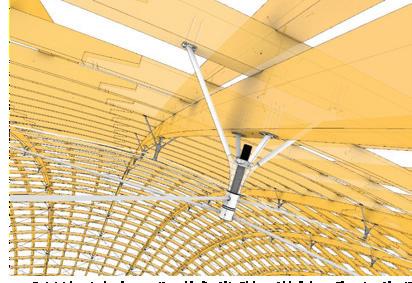
for certain building types, but leaves a large proportion of buildings unaddressed. Manufacturers’ systems often limit creativity and only provide region-specific solutions.
The question must be asked. Will robots, AI, 3D printing or prefab as individual technologies create the increase in efficiency our industry needs, or does the real problem lie in the traditional design and procurement processes?
Branch, a new software platform, provides real-time structural analysis and manufacturing/assembly feedback to designers, connecting the entirety of the design-manufacture-assemble process. Analysis, design, connection detailing, CNC file generation, logistics, and assembly are incorporated into a single Rhino-based platform, enabling direct integration with the site and building performance analysis tools readily available within the Rhino ecosystem. A NEW APPROACH The AEC industry can no longer afford the time and cost of resolving the complexity of building in a process where designers are disconnected from construction. Unlike other industries, where the end result is a product into which years and copious amounts of R&D money can be poured, the building industry requires a more flexible and responsive solution. What is needed is an industrywide change in the design and procurement process – a reconnection of design to both manufacturing and construction. With the BIM revolution, the focus has been on the M: modeling. and creating digital “twins” that are accurate and highly detailed models and drawings which represent the design. However, our building industry does not need increasingly more detailed 3D models. It needs smarter software – that knows how to design, for manufacture and assembly (DfMA). This next generation of design software is not about product catalogues: it is about understanding and predicting design intent.
As a new construction material, mass timber has become a catalyst for design and construction firms to question the somewhat disjointed design-bid-manufacture-construct process so prevalent in our industry. Vertically integrated companies are disrupting the traditional procurement model by bringing the control of manufacturing and assembly processes directly into designers’ hands. Mass timber uniquely encourages this – allowing designers to integrate DfMA into their design processes.

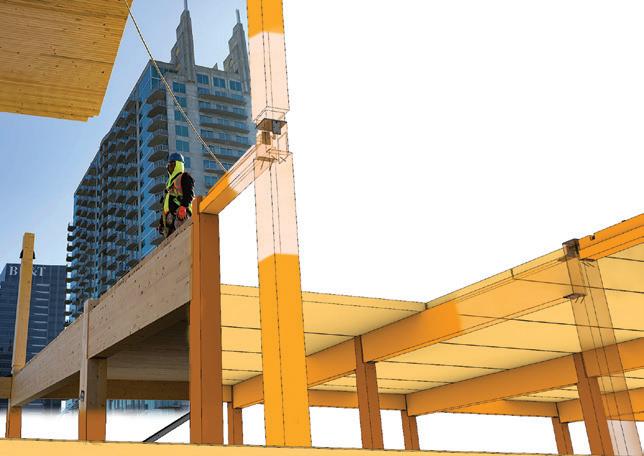
Designers, as a result, will embed the manufacturing and assembly process into their designs. Material availability, milling processes, shipping and prefab techniques suddenly become design mandates, not peripheral considerations talked about briefly and then left for “post-tender.”
With DfMA constraints embedded into design software, more rapid customization and design exploration can be performed on projects without significant cost and schedule implications. This new paradigm will be enabled by the advent of design software which takes this thinking out of the realm of specific companies and brings it to the wider design community.
Mass timber as the newest (and perhaps oldest) building material is central to this revolution in the building design process. Its ability to enable mass customization is driving a new breed of design software, design processes and delivery models across our industry.
Design – not manufacturing processes, robots or drones – is the key to creating efficiency in the AEC industry. The next challenge is creating design software and tools which are both manufacturing- and construction-aware, led by vertically integrated companies focused on enabling realtime data flow between all stakeholders, whether designers, machinists or foremen.
What we have been trying to do for the past 23 years is bring design back into construction. Perhaps our industry will move back to the master-builder paradigm from where it originated. Back to a place where architects and engineers are also builders. Back to the future.
Lucas Epp is vice president and head of engineering at StructureCraft. He can be reached at lepp@structurecraft.com or 604.940.8889.
